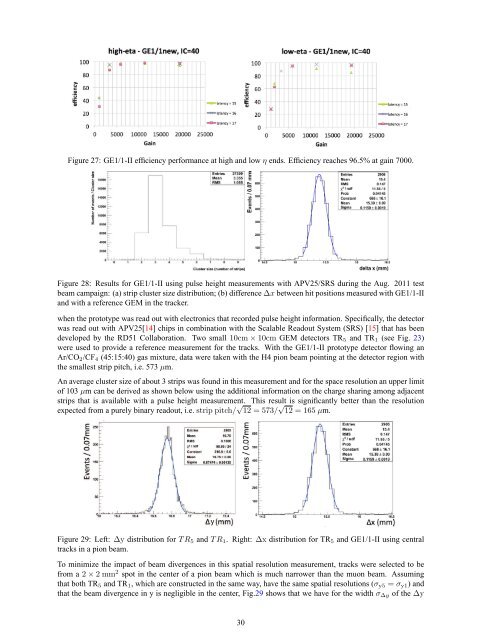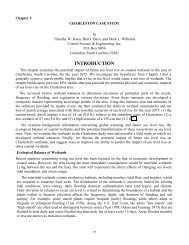A GEM Detector System for an Upgrade of the CMS Muon Endcaps
A GEM Detector System for an Upgrade of the CMS Muon Endcaps
A GEM Detector System for an Upgrade of the CMS Muon Endcaps
You also want an ePaper? Increase the reach of your titles
YUMPU automatically turns print PDFs into web optimized ePapers that Google loves.
Figure 27: GE1/1-II efficiency per<strong>for</strong>m<strong>an</strong>ce at high <strong>an</strong>d low η ends. Efficiency reaches 96.5% at gain 7000.<br />
Figure 28: Results <strong>for</strong> GE1/1-II using pulse height measurements with APV25/SRS during <strong>the</strong> Aug. 2011 test<br />
beam campaign: (a) strip cluster size distribution; (b) difference∆x between hit positions measured with GE1/1-II<br />
<strong>an</strong>d with a reference <strong>GEM</strong> in <strong>the</strong> tracker.<br />
when <strong>the</strong> prototype was read out with electronics that recorded pulse height in<strong>for</strong>mation. Specifically, <strong>the</strong> detector<br />
was read out with APV25[14] chips in combination with <strong>the</strong> Scalable Readout <strong>System</strong> (SRS) [15] that has been<br />
developed by <strong>the</strong> RD51 Collaboration. Two small 10cm×10cm <strong>GEM</strong> detectors TR5 <strong>an</strong>d TR1 (see Fig. 23)<br />
were used to provide a reference measurement <strong>for</strong> <strong>the</strong> tracks. With <strong>the</strong> GE1/1-II prototype detector flowing <strong>an</strong><br />
Ar/CO2/CF4 (45:15:40) gas mixture, data were taken with <strong>the</strong> H4 pion beam pointing at <strong>the</strong> detector region with<br />
<strong>the</strong> smallest strip pitch, i.e. 573 µm.<br />
An average cluster size <strong>of</strong> about 3 strips was found in this measurement <strong>an</strong>d <strong>for</strong> <strong>the</strong> space resolution <strong>an</strong> upper limit<br />
<strong>of</strong> 103 µm c<strong>an</strong> be derived as shown below using <strong>the</strong> additional in<strong>for</strong>mation on <strong>the</strong> charge sharing among adjacent<br />
strips that is available with a pulse height measurement. This result is signific<strong>an</strong>tly better th<strong>an</strong> <strong>the</strong> resolution<br />
expected from a purely binary readout, i.e. strip pitch/ √ 12 = 573/ √ 12 = 165 µm.<br />
y<br />
Figure 29: Left: ∆y distribution <strong>for</strong> TR5 <strong>an</strong>d TR1. Right: ∆x distribution <strong>for</strong> TR5 <strong>an</strong>d GE1/1-II using central<br />
tracks in a pion beam.<br />
To minimize <strong>the</strong> impact <strong>of</strong> beam divergences in this spatial resolution measurement, tracks were selected to be<br />
from a 2×2mm 2 spot in <strong>the</strong> center <strong>of</strong> a pion beam which is much narrower th<strong>an</strong> <strong>the</strong> muon beam. Assuming<br />
that both TR5 <strong>an</strong>d TR1, which are constructed in <strong>the</strong> same way, have <strong>the</strong> same spatial resolutions (σy5 = σy1) <strong>an</strong>d<br />
that <strong>the</strong> beam divergence in y is negligible in <strong>the</strong> center, Fig.29 shows that we have <strong>for</strong> <strong>the</strong> width σ∆y <strong>of</strong> <strong>the</strong> ∆y<br />
30
















